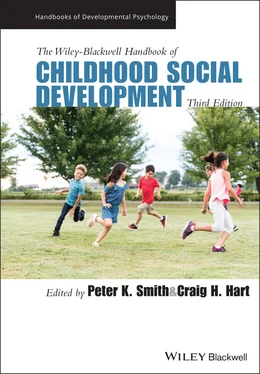149 Perry, D. G., Kusel, S. J., & Perry, L. C. (1988). Victims of peer aggression. Developmental Psychology, 24, 807–814.
150 Petersen, A. C., & Hamburg, B. A. (1986). Adolescence: A developmental approach to problems and psychopathology. Behavior Therapy, 17, 480–499.
151 Phillips, D., McCartney, K., & Scarr, S. (1987). Child care quality and children’s social development. Developmental Psychology, 23, 537–543.
152 Pinquart, M., & Kauser, R. (2018). Do the associations of parenting styles with behavior problems and academic achievement vary by culture? Results from a meta‐analysis. Cultural Diversity and Ethnic Minority Psychology, 24(1), 75–100.
153 Plomin, R. (1995). Genetics and children’s experiences in the family. Journal of Child Psychology and Psychiatry, 36, 33–68.
154 Raver, C. C., & Zigler, E. (1997). Social competence: An untapped dimension in evaluating head start’s success. Early Childhood Research Quarterly, 12(4), 363–385.
155 Raudenbush, S., & Bryk, A. (2002). Hierarchical linear models: Applications and data analysis methods (2nd ed.). Sage.
156 Reijntjes, A., Kamphuis, J. H., Prinzie, P., Boelen, P. A., van der Schoot, M., & Telch, M. J. (2011). Prospective linkages between peer victimization and externalizing problems in children: a meta‐analysis. Aggressive Behavior, 37, 215–222.
157 Reijntjes, A., Kamphuis, J. H., Prinzie, P., & Telch, M. J. (2010). Peer victimization and internalizing problems in children: A meta‐analysis of longitudinal studies. Child Abuse and Neglect, 34, 244–252.
158 Ristori, J., & Steensma, T. D. (2016). Gender dysphoria in childhood. International Review of Psychiatry, 28, 13–20.
159 Rivas‐Drake, D., Seaton, E. K., Markstrom, C., Quintana, S., Syed, M., Lee, R. M., Schwartz, S. J., Umaña‐Taylor, A. J., French, S., & Yip, T. (2014). Ethnic and racial identity in adolescence: Implications for psychosocial, academic, and health outcomes. Child Development, 85, 40–57.
160 Rogers‐Sirin, L., Ryce, P., & Sirin, S. (2014). Acculturation, acculturative stress, and cultural mismatch and their influences on immigrant children and adolescents’ well‐being. In R. Dimitrova, M. Bender, & F. van de Vijver (Eds.), Global perspectives on well‐being in immigrant families. Advances in immigrant family research (Vol. 1, pp. 11–30). Springer.
161 Rosario, M., & Schrimshaw, E. W. (2013). The sexual identity development and health of lesbian, gay, and bisexual adolescents: An ecological perspective. In C. J. Patterson & A. R. D'Augelli (Eds.), Handbook of psychology and sexual orientation (pp. 87–101). Oxford University Press.
162 Roseth, C. J., Fang, F., Johnson, D. W., & Johnson, R. T. (2006). Effects of cooperative learning on middle school students: A meta‐analysis. American Educational Research Association.
163 Rothbart, M. K. (2007).Temperament, development, and personality. Current Directions in Psychological Science, 16(4), 207–212.
164 Rothbart, M. K., Sheese, B. E., Rueda, M. R., & Posner, M. I. (2011). Developing mechanisms of self‐regulation in early life. Emotion Review, 3(2), 207–213.
165 Roy, P., Rutter, M., & Pickles, A. (2004). Institutional care: associations between overactivity and lack of selectivity in social relationships. Journal of Child Psychology and Psychiatry, 45, 866–873.
166 Russell, A., Hart, C. H., Robinson, C.C., & Olsen, S. F. (2003). Children’s sociable and aggressive behaviour with peers: A comparison of the US and Australia, and contributions of temperament and parenting styles. International Journal of Behavioral Development, 27, 74–86.
167 Rutter, M. (1996). Transitions and turning points in developmental psychopathology: As applied to the age span between childhood and mid‐adulthood. International Journal of Behavioral Development, 19, 603–626.
168 Rutter, M. (2006). Genes and behavior. Blackwell.
169 Rutter, M., Kreppner, J., & O'Connor, T. (2001). Specificity and heterogeneity in children's responses to profound institutional privation. British Journal of Psychiatry, 179, 97–103.
170 Ryan, J. P., Hong, J. S., Herz, D., & Hernandez, P. M. (2010). Kinship foster care and the risk of juvenile delinquency. Children and Youth Services Review, 32(12), 1823–1830.
171 Salmivalli, C., & Poskiparta, E. (2012). KiVa antibullying program: Overview of evaluation studies based on a randomized controlled trial and national rollout in Finland. International Journal of Conflict and Violence, 6, 294–302.
172 Sameroff, A. (2009). The transactional model. In A. Sameroff (Ed.), The transactional model of development: How children and contexts shape each other (pp. 3–21). American Psychological Association.
173 Sameroff, A. J., & Chandler, M. J. (1975). Reproductive risk and the continuum of caretaking causality. In Horowitz, F. D. (Ed.), Review of Child Development Research (Vol. 4, pp. 187–244). Chicago: University of Chicago Press.
174 Sawyerr, A., & Bagley, C. (2017). Child sexual abuse and adolescent and adult adjustment: A review of British and world evidence, with implications for social work, and mental health and school counselling. Advances in Applied Sociology, 7, 1–15.
175 Scarr, S., & McCartney, K. (1983). How people make their own environments: A theory of genotype →environment effects. Child Development, 54, 424–435.
176 Schaefer, D. R., Simpkins, D. D., Vest, A. E., & Price, C. D. (2011). The contribution of extracurricular activities to adolescent friendships. Developmental Psychology, 47, 1141–1152.
177 Schermerhorn, A. C., Chow, S.‐M., & Cummings, E. M. (2010). Developmental family processes and interparental conflict: Patterns of microlevel influences. Developmental Psychology, 46(4), 869–885.
178 Schwartz, D. (2000). Subtypes of victims and aggressors in children’s peer groups. Journal of Abnormal Child Psychology, 28, 181–192.
179 Sears, R. (1975). Your ancients revisited: A history of child development. In E. M. Hetherington (Ed.), Review of child development research (Vol. 5, pp. 1–80). Chicago: University of Chicago Press.
180 Sedlak, A.J., Mettenburg, J., Basena, M., Petta, I., McPherson, K., Greene, A., & Li, S. (2010). Fourth National Incidence Study of Child Abuse and Neglect (NIS‐4): Report to Congress, executive summary. Office of Planning, Research and Evaluation. https://www.acf.hhs.gov/opre/report/fourth‐national‐incidence‐study‐child‐abuse‐and‐neglect‐nis‐4‐report‐congress‐executive
181 Shonkoff, J. P., & Phillips, D. A. (2000). From neurons to neighborhoods. National Academy Press.
182 Smetana, J. G., Jambon, M., & Ball, C. (2014). The social domain approach to children’s moral judgments. In M. Killen & J. G. Smetana (Eds.), Handbook of moral development (pp. 23–45). Psychology Press.
183 Smith, P. K., Kwak, K., & Toda, Y. (Eds.). (2016). School bullying in different cultures: eastern and western perspectives. Cambridge University Press.
184 Steensma, T. D., & Cohen‐Kettenis, P. T. (2015). More than two developmental pathways for children with gender dysphoria? Journal of the American Academy of Child and Adolescent Psychiatry, 54, 147.
185 Susman, S., Skara, S., & Ames, S. L., (2008). Substance abuse among adolescents. Substance Use and Misuse, 43, 1802–1828.
186 Tangney, J. P., & Dearing, R. L. (2002). Shame and guilt. New York: Guilford Press.
187 Thelen, E. (1989). Self‐organization in developmental processes: Can systems approaches work? In M. Gunnar & E. Thelen (Eds.), Systems and development. Minnesota symposium in child psychology (Vol. 22, pp. 77–117). Erlbaum.
188 Thomas, A., Chess, S., & Birch, H. G. (1968). Temperament and behavior disorders in children. New York University Press.
189 Thompson, R. A. (2013). Attachment theory and research: Precis and prospect. In P. D. Zelazo (Ed.), Oxford handbook of developmental psychology. Vol 2. Self and other (pp. 191–216). Oxford University Press.
Читать дальше












